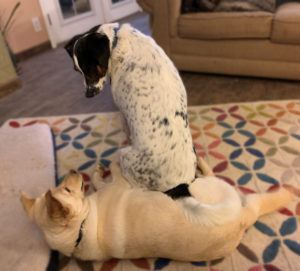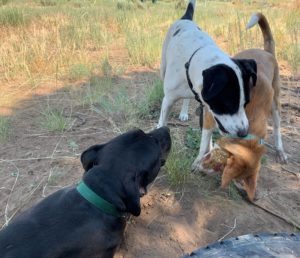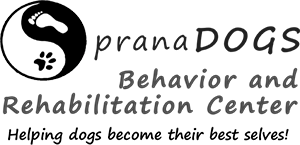 Observing the dogs while they’re here and noting their behaviors, attitudes and interactions is a key part of my job. Obviously sculpting behaviors is huge but throughout their entire stay, observation is imperative. And a key piece in observing dog behavior, is observing the dogs around them.
Observing the dogs while they’re here and noting their behaviors, attitudes and interactions is a key part of my job. Obviously sculpting behaviors is huge but throughout their entire stay, observation is imperative. And a key piece in observing dog behavior, is observing the dogs around them.
Let’s face it, we’re humans so we’re always going to be at a loss picking up subtle communication between dogs (the angle of our vision alone makes it harder for us) so use other dogs to tell you what’s going on. Does the dog invite dogs near them or do dogs give them distance? This key question will tell you volumes about your dog.
Recently, I reported back to an organization, “she seems great but in reality she’s throwing a bunch of ‘don’t push me’ signals to the other dogs.”
You wouldn’t notice it if you weren’t a dog person and were just noticing the dogs. She’d stand right next to them or circle with them around me or let them walk between her and me. But if you watched closely, it wouldn’t take long before she’d push all the dogs backwards just a little, then a little more.
This particular dog had a low (don’t, screw with me) growl that was accompanied by a slightly stiff body and drop of her head. A head drop isn’t normally a pushy behavior in dogs but she’s not a big girl and accompanied with the other behaviors it was getting her point across. As I watched her work her way in with the others their responses were key to me picking up on her subtle but important issues. I never heard her growl until I paid closer attention.
In another example, I have two bedrooms that have been retrofitted for dogs. Each has a comfy couch, crates and dog beds. Inevitably, if I don’t manage the rooms a particular dog will be in one room and all the remaining dogs will be in the other. This says volumes. All these kiddos prefer couches to their kennels but will let this dog, who is only 35 pounds, have the couch and entire room to himself.
You’d think this dog was fine, he plays with a couple of other dogs in a decent manner. He mounts too much but loves to run and be chased. But the fact that no one will sleep on the couch with him proves that he’s still not handling himself well. These dogs are typically either unpredictable or their response is too much.
If a dog attempts to get on the couch with him and he goes after them immediately and in such a way that doesn’t make them feel comfy there at all, his response is too much. But if instead (as is the case here) the dog seems fine for the most part but suddenly the other dog does something wrong – like stretching out or changing position – and he loses his mind, this is the unpredictable dog.
I’ve been working with a family who’s got a large dog who has only played with his sister his whole life. We’ve been doing some play-dates with another dog to give him time to learn how to play with a dog who helps school him, but doesn’t hold a grudge. The parents have been very concerned about how hard their dog comes on and my response to them is always the same, “watch the other dog. If he keeps coming back for more than he’s okay with it. And if he’s okay with it, we’re okay with it.”
The greatest bit is anyone can do it. Just watch dogs, the more you watch, the more you learn. If you’re wondering if your dog is a good player, watch how other dogs act around him or her. Are dogs excited when yours gets to the park or do they run in the opposite direction? Dogs are constantly communicating amongst themselves – it’s up to us to pick up the signals.

Appropriate Dogs are the Best Dog Trainers!
